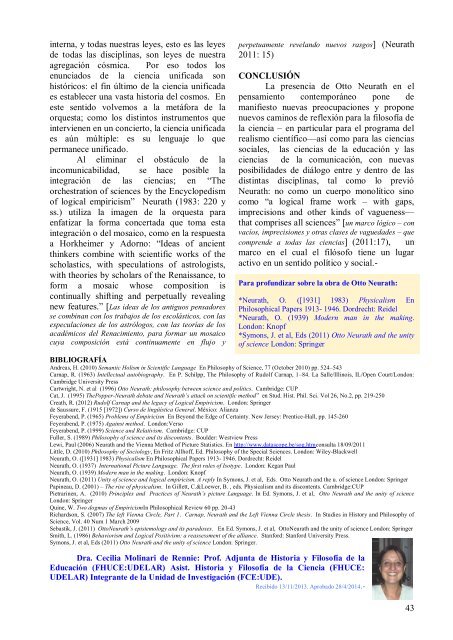ariel-14
ariel-14
ariel-14
You also want an ePaper? Increase the reach of your titles
YUMPU automatically turns print PDFs into web optimized ePapers that Google loves.
interna, y todas nuestras leyes, esto es las leyes<br />
de todas las disciplinas, son leyes de nuestra<br />
agregación cósmica. Por eso todos los<br />
enunciados de la ciencia unificada son<br />
históricos: el fin último de la ciencia unificada<br />
es establecer una vasta historia del cosmos. En<br />
este sentido volvemos a la metáfora de la<br />
orquesta; como los distintos instrumentos que<br />
intervienen en un concierto, la ciencia unificada<br />
es aún múltiple: es su lenguaje lo que<br />
permanece unificado.<br />
Al eliminar el obstáculo de la<br />
incomunicabilidad, se hace posible la<br />
integración de las ciencias; en “The<br />
orchestration of sciences by the Encyclopedism<br />
of logical empiricism” Neurath (1983: 220 y<br />
ss.) utiliza la imagen de la orquesta para<br />
enfatizar la forma concertada que toma esta<br />
integración o del mosaico, como en la respuesta<br />
a Horkheimer y Adorno: “Ideas of ancient<br />
thinkers combine with scientific works of the<br />
scholastics, with speculations of astrologists,<br />
with theories by scholars of the Renaissance, to<br />
form a mosaic whose composition is<br />
continually shifting and perpetually revealing<br />
new features.” [Las ideas de los antiguos pensadores<br />
se combinan con los trabajos de los escolásticos, con las<br />
especulaciones de los astrólogos, con las teorías de los<br />
académicos del Renacimiento, para formar un mosaico<br />
cuya composición está continuamente en flujo y<br />
perpetuamente revelando nuevos rasgos] (Neurath<br />
2011: 15)<br />
CONCLUSIÓN<br />
La presencia de Otto Neurath en el<br />
pensamiento contemporáneo pone de<br />
manifiesto nuevas preocupaciones y propone<br />
nuevos caminos de reflexión para la filosofía de<br />
la ciencia – en particular para el programa del<br />
realismo científico—así como para las ciencias<br />
sociales, las ciencias de la educación y las<br />
ciencias de la comunicación, con nuevas<br />
posibilidades de diálogo entre y dentro de las<br />
distintas disciplinas, tal como lo previó<br />
Neurath: no como un cuerpo monolítico sino<br />
como “a logical frame work – with gaps,<br />
imprecisions and other kinds of vagueness—<br />
that comprises all sciences” [un marco lógico – con<br />
vacíos, imprecisiones y otras clases de vaguedades – que<br />
comprende a todas las ciencias] (2011:17), un<br />
marco en el cual el filósofo tiene un lugar<br />
activo en un sentido político y social.-<br />
Para profundizar sobre la obra de Otto Neurath:<br />
*Neurath, O. ([1931] 1983) Physicalism En<br />
Philosophical Papers 1913- 1946. Dordrecht: Reidel<br />
*Neurath, O. (1939) Modern man in the making.<br />
London: Knopf<br />
*Symons, J. et al, Eds (2011) Otto Neurath and the unity<br />
of science London: Springer<br />
BIBLIOGRAFÍA<br />
Andreas, H. (2010) Semantic Holism in Scientific Language En Philosophy of Science, 77 (October 2010) pp. 524–543<br />
Carnap, R. (1963) Intellectual autobiography. En P. Schilpp, The Philosophy of Rudolf Carnap, 1–84. La Salle/Illinois, IL/Open Court/London:<br />
Cambridge University Press<br />
Cartwright, N. et al (1996) Otto Neurath: philosophy between science and politics. Cambridge: CUP<br />
Cat, J. (1995) ThePopper-Neurath debate and Neurath’s attack on scientific method” en Stud. Hist. Phil. Sci. Vol 26, No.2, pp. 219-250<br />
Creath, R. (2012) Rudolf Carnap and the legacy of Logical Empiricism. London: Springer<br />
de Saussure, F. (1915 [1972]) Curso de lingüística General. México: Alianza<br />
Feyerabend, P. (1965) Problems of Empiricism En Beyond the Edge of Certainty. New Jersey: Prentice-Hall, pp. <strong>14</strong>5-260<br />
Feyerabend, P. (1975) Against method. London:Verso<br />
Feyerabend, P. (1999) Science and Relativism. Cambridge: CUP<br />
Fuller, S. (1989) Philosophy of science and its discontents. Boulder: Westview Press<br />
Lewi, Paul (2006) Neurath and the Vienna Method of Picture Statistics. En http://www.datascope.be/sog.htmconsulta 18/09/2011<br />
Little, D. (2010) Philosophy of Sociology, En Fritz Allhoff, Ed. Philosophy of the Special Sciences. London: Wiley-Blackwell<br />
Neurath, O. ([1931] 1983) Physicalism En Philosophical Papers 1913- 1946. Dordrecht: Reidel<br />
Neurath, O. (1937) International Picture Language. The first rules of Isotype. London: Kegan Paul<br />
Neurath, O. (1939) Modern man in the making. London: Knopf<br />
Neurath, O. (2011) Unity of science and logical empiricism. A reply In Symons, J. et al, Eds. Otto Neurath and the u. of science London: Springer<br />
Papineau, D. (2001) – The rise of physicalism. In Gillett, C.&Loewer, B. , eds. Physicalism and its discontents. Cambridge:CUP<br />
Pietrarinen, A. (2010) Principles and Practices of Neurath’s picture Language. In Ed. Symons, J. et al, Otto Neurath and the unity of science<br />
London: Springer<br />
Quine, W. Two dogmas of EmpiricismIn Philosophical Review 60 pp. 20-43<br />
Richardson, S. (2007) The left Vienna Circle, Part 1. Carnap, Neurath and the Left Vienna Circle thesis. In Studies in History and Philosophy of<br />
Science, Vol. 40 Num 1 March 2009<br />
Sebastik, J. (2011) OttoNeurath’s epistemology and its paradoxes. En Ed. Symons, J. et al, OttoNeurath and the unity of science London: Springer<br />
Smith, L. (1986) Behaviorism and Logical Positivism: a reassessment of the alliance. Stanford: Stanford University Press.<br />
Symons, J. et al, Eds (2011) Otto Neurath and the unity of science London: Springer.<br />
Dra. Cecilia Molinari de Rennie: Prof. Adjunta de Historia y Filosofía de la<br />
Educación (FHUCE:UDELAR) Asist. Historia y Filosofía de la Ciencia (FHUCE:<br />
UDELAR) Integrante de la Unidad de Investigación (FCE:UDE).<br />
Recibido 13/11/2013. Aprobado 28/4/20<strong>14</strong>.-<br />
43


